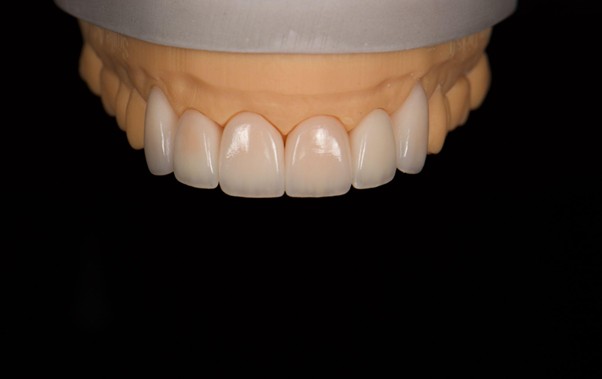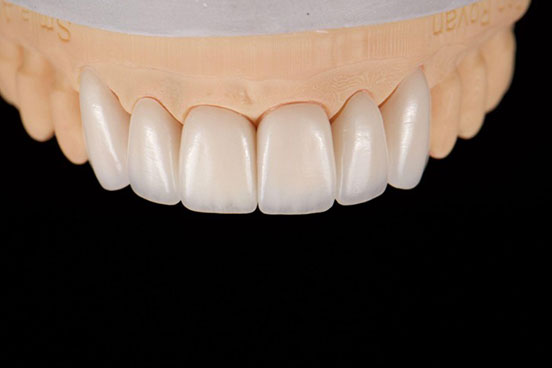When selecting the right ceramic material for restorations, the choice often boils down to zirconia and lithium disilicate, commonly known by its popular brand name, e.max. Both materials yield excellent results in the appropriate context, but understanding when to utilise each can significantly impact longevity, aesthetics, and patient satisfaction. At Smile Art Lab, we’ve seen that both materials yield excellent results in the appropriate context, but understanding when to utilise each can significantly impact longevity, aesthetics, and patient satisfaction.
Understanding the Materials
e.max (Lithium Disilicate) is a glass-ceramic valued for its high translucency and natural appearance. It is often the preferred choice for anterior restorations and veneers because of its ability to replicate enamel. Although it is not as strong as zirconia, it offers adequate durability for most single-unit restorations, including inlays, onlays, and crowns in areas with moderate loads.
Zirconia is a high-strength polycrystalline ceramic that has significantly evolved in recent years. Initially used for posterior crowns and frameworks, modern versions now provide improved translucency, making them suitable even in aesthetic zones, particularly when strength is essential.
Strength and Indications
Zirconia has a flexural strength of 900–1200 MPa and a fracture toughness of 4–8 MPa·m½. It’s ideal for:
- Long-span bridges
- Crowns
- Implant-supported restorations
- Full-arch reconstructions
Zirconia is often the better choice if you have heavy occlusion, bruxism, or require a material that is extremely resistant to fracture.
e.max, on the other hand, has a flexural strength of approximately 400 MPa (depending on processing) and a fracture toughness of 2.5–3.5 MPa·m½. It’s more appropriate for:
- Veneers (including no-prep or minimal-prep)
- Inlays and onlays
- Anterior crowns
- Short-span bridges up to the premolars (if design and occlusion allow)
In our experience, e.max works particularly well for anterior veneers. For darker preparations, we typically suggest a layered version to more effectively mask the underlying shade while maintaining aesthetic translucency.
Aesthetics and Translucency
If a patient is concerned about achieving highly natural results, particularly in the anterior, e.max is hard to beat. Its glass-ceramic structure allows light to pass through and scatter in a way that mimics natural enamel. Furthermore, it can be customised through layering or staining.
Zirconia has made significant advancements, especially with multilayered and higher-translucency generations like 5Y zirconia. These newer types are more commonly used for anterior crowns, yet they still exhibit limitations regarding depth and warmth when directly compared to lithium disilicate.
Cementation and Preparation
e.max is etched and silanated, then bonded with resin cement, which enhances its strength and allows for more conservative preparations. It’s ideal when isolation can be achieved and minimal reduction is preferred.
Zirconia requires a different protocol. It can be cemented conventionally or bonded with resin, giving clinicians more flexibility in situations where moisture control is a concern. At Smile Art Lab, we use a special etching for zirconia that allows you to bond it the same way you would bond Emax.
Biocompatibility
Both materials are biocompatible and well tolerated by soft tissues. Zirconia is particularly inert and is often selected for patients with allergies to metals or resins. e.max also integrates effectively with soft tissue and demonstrates stable results over time, especially in cosmetic areas.
- Survival Rates and Clinical Evidence
- Zirconia crowns: 95%+ survival at 10 years.
- max crowns: 90% survival at 10 years.
- max bridges: limited data available; survival decreases beyond the 3-unit span.
- Zirconia bridges: long-term data supports their use even in full-arch cases.
Summary Table
| Indication | e.max (Lithium Disilicate) | Zirconia |
| Veneers | First choice, excellent aesthetics | Can be used with layering (dark preps) |
| Inlays/Onlays | Strong and conservative | Less aesthetic, more durable |
| Anterior Crowns | Natural translucency, ideal for front teeth | Used when strength outweighs translucency |
| Posterior Crowns | Good if load is moderate | Best for high-load cases |
| Bridges | Up to 3-unit, ideally to second premolar | Preferred for longer spans |
| Implants | Can be used with ceramic abutments | Excellent with zirconia abutments |
| Full Arch | Not recommended | Strong and predictable |
Clinical Considerations and Workflow Integration
When deciding between e.max and zirconia, clinicians must also consider how each material integrates into the broader clinical workflow. Factors such as preparation design, digital versus traditional impressions, shade communication, and laboratory capabilities all influence the final outcome.
Digital workflows have become increasingly popular, and both zirconia and e.max are compatible with chairside and lab-based CAD/CAM systems. Zirconia has become more practical for same-day dentistry due to advancements in high-speed sintering furnaces, which can process single-unit crowns in under 30 minutes after milling. However, e.max CAD remains the most common material for chairside restorations, as it provides a straightforward workflow; milled crowns are simply crystallised in a furnace for about 25–30 minutes, resulting in excellent aesthetics for single units.
Communication with the dental laboratory is particularly crucial for anterior restorations. When working with e.max, detailed stump shade recordings and photos with shade tabs are essential. Since the final appearance depends on both the ceramic and the underlying tooth structure, precise shade communication ensures the best possible aesthetic result.

Customisation and Layering Options
Aesthetically driven patients will often push the limits of what ceramics can do, particularly for anterior teeth. In such cases, customisation is essential:
- e.max lends itself beautifully to cut-back and layering techniques, allowing ceramists to add depth and characterisation that mimic natural tooth anatomy. This is ideal for patients with high aesthetic demands.
- Zirconia, especially the newer 4Y and 5Y translucent variants, can be monolithically milled for posterior strength while still offering decent translucency. For anterior work, a layered zirconia approach combines strength with improved optics. That said, zirconia still falls slightly short of e.max in replicating natural light dynamics, especially in highly visible zones.
Conclusion
Both e.max and zirconia have secured their place in modern restorative dentistry, but their strengths reside in different areas. If the aim is to achieve lifelike aesthetics in the anterior zone with minimal preparation, e.max remains unparalleled. However, for strength, reliability, and long-span cases, zirconia is the definitive winner. Ultimately, the choice of material should reflect the clinical situation, occlusal load, preparation design, and aesthetic objectives. By comprehending how each material performs and where it excels, dentists can confidently provide durable, beautiful restorations tailored to each patient. At Smile Art Lab, we specialise in crafting high-quality zirconia and e.max restorations, including crowns, veneers, inlays, onlays, bridges, and implant-supported solutions. Get in touch with us today and discover how our advanced digital workflows, expert craftsmanship, and personalised support can help you deliver outstanding results with every case.
FAQs
Q1: Is e.max strong enough for second molars?
A: While e.max can be used for second molars under light to moderate occlusal forces, caution is advised. For patients with heavy occlusion or bruxism, zirconia is the safer and more predictable option.
Q2: Can zirconia be bonded as reliably as e.max?
A: Yes, you can! At Smile Art Lab, we utilise a specialised acid etching technique for zirconia, enabling it to be bonded with the same adhesive workflow as e.max. This method delivers strong and durable results.
Q3: Which material is best for masking discoloured preps or metal cores?
A: Both materials can be used, but layered e.max with high-opacity ingots tends to provide superior aesthetic results. Alternatively, opaque zirconia can be used, but may require more space and may not match the translucency of adjacent teeth.
Q4: Are there differences in margin design requirements between the two materials?
A: Yes. e.max requires smooth, rounded, and more defined margins due to its glass-ceramic nature. Zirconia, on the other hand, is more forgiving and can accommodate feather-edge or knife-edge margins, although a chamfer or shoulder is still preferred for best results.
Q5: How do the costs compare between e.max and zirconia?
A: Zirconia restorations, especially monolithic ones, tend to be more cost-effective due to faster processing and fewer lab steps. e.max restorations particularly those that are hand-layered may involve more laboratory time and skill, making them slightly more expensive. However, the difference is generally marginal and should be weighed against clinical benefits.
Q6: Are both materials suitable for patients with allergies?
A: Yes. Both zirconia and e.max are biocompatible and metal-free, making them suitable for patients with metal allergies. Zirconia, being highly inert, is often chosen for cases involving sensitivity or allergic reactions to other dental materials.
Q7: Can these materials be used on implants?
A: At Smile Art Lab, we don’t use full e.max crowns on implants due to the risk of cracking if they ever need to be removed (debonded). Instead, we offer e.max porcelain layered over a zirconia framework for implant restorations. Zirconia continues to be our primary material for implant-supported crowns and bridges, especially in posterior or full-arch cases, because of its strength and reliability.

